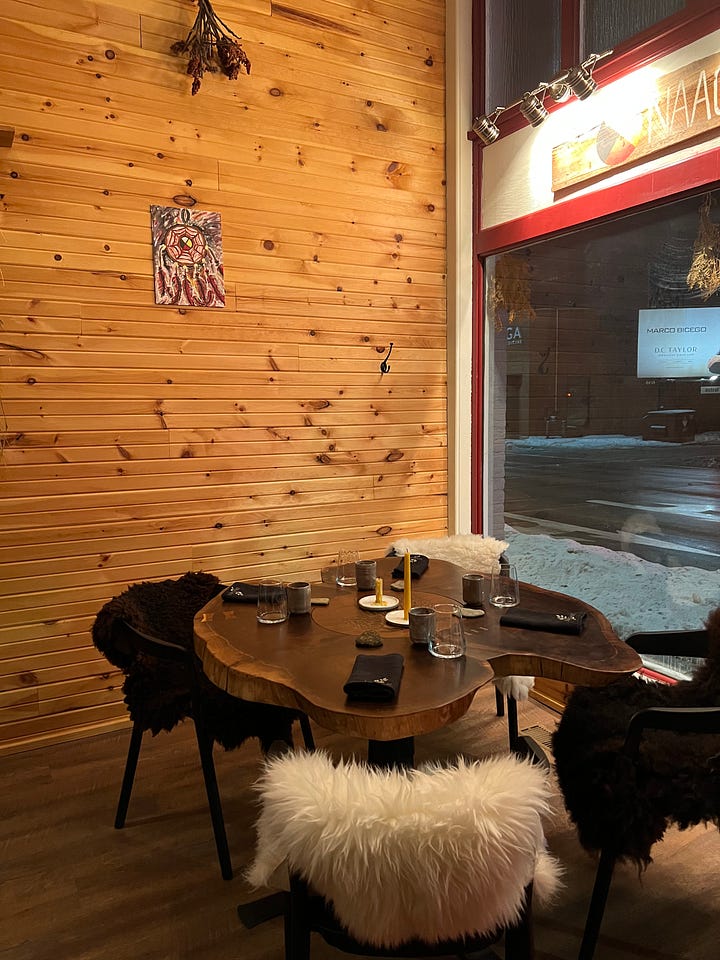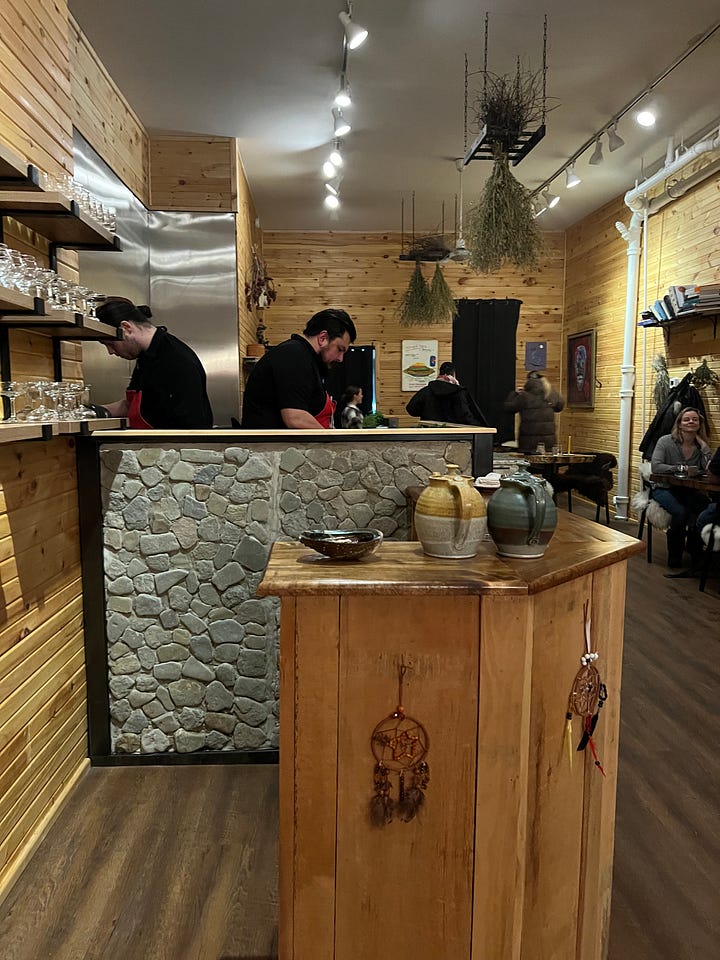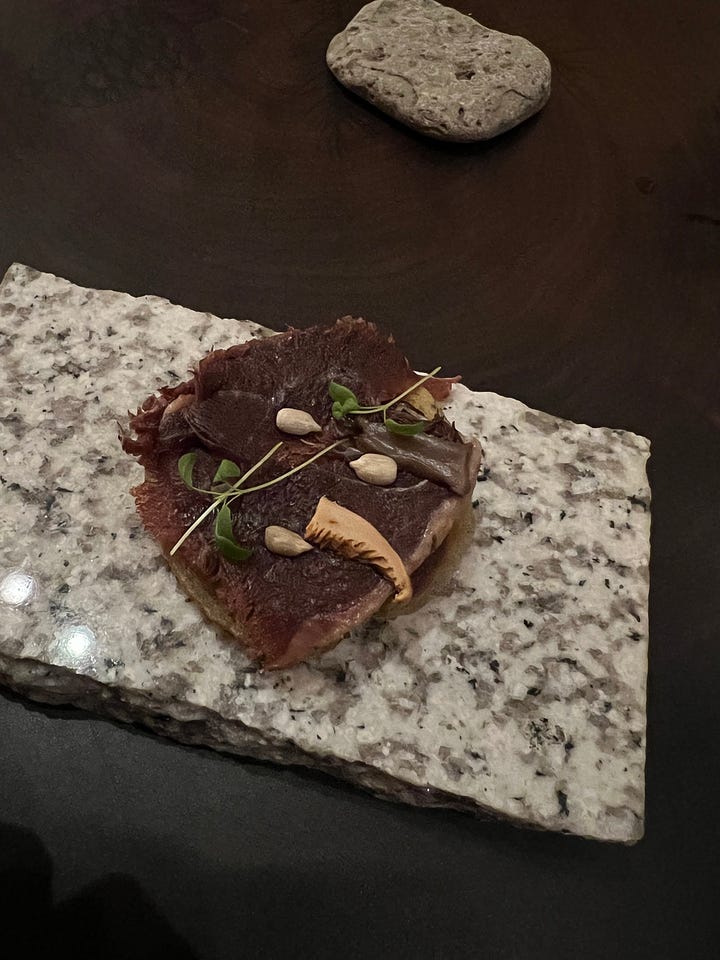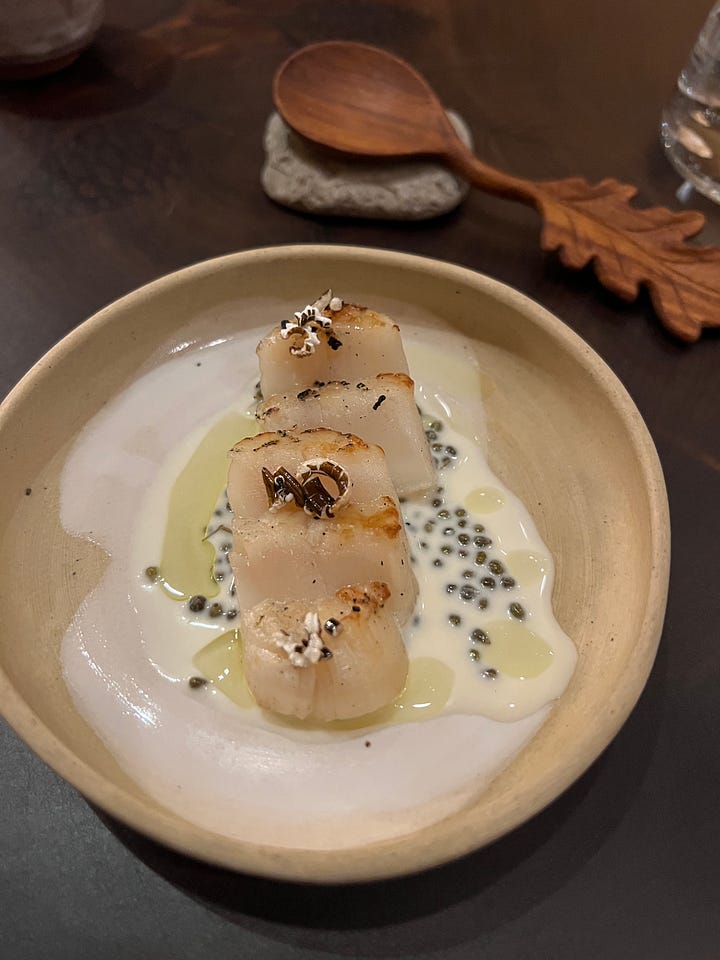Naagan, and the difficult task of making Indigenous food mainstream.
Adapted from: Canadian Indigenous cuisine.
Despite being a food city built on land rich with Indigenous history, there are few opportunities to try Indigenous cuisine in Toronto. This is not a coincidence, of course, but the inevitable outcome of the Canadian genocide of Indigenous peoples. How can a cuisine stand a chance against the assimilative forces of residential schools, the forced poverty of the reservation system, and the destruction of its traditional foodways? How can the custom of hunting and eating wild game be widely celebrated in a system that prohibits it?
Such questions heightened my anticipation around this meal at Naagan, a 12-course tasting menu of progressive Indigenous cuisine from chef Zach Keeshig. Keeshig is from the Chippewas of Nawash Unceded First Nation reserve, not too far from where the restaurant is today. His cooking showcases a reverence for hyper-local ingredients and Indigenous traditions refracted through a career in fine dining kitchens, with previous tenures at Michelin-friendly places like Eigensinn Farm, Restaurant Pearl Morissette, and Langdon Hall. J. and I have been following his career and pop-ups for a few years, but never got the occasion to taste the full gamut of his cooking until now. Candidly, I had no idea what to expect.
Naagan, on a Saturday in January.


The space seats 17 and holds all of the comforts of a log cabin, with live-edge wood slab tables and chairs cushioned by faux fur. Pickled and dried ingredients in jars line its walls; herbs and flowers dangle from its ceilings. We were seated at a table with a direct view of animal pelts—an otter and fisher, our server informed us—and served a glass of cedar tea.
The menu is built on a few principles that honour Keeshig’s culture: the drink pairings are nonalcoholic (not available the night we went, due to a sick FOH team member that left the restaurant short-staffed); the ingredients are either foraged by the team, or sourced from local farmers, fishers, and hunters; common flavour-builders like lemon and black pepper are substituted by local alternatives, like seabuckthorn and alder. I love a good creative constraint. It’s a gutsy move, one that challenges the common belief that Indigenous cuisine is basic, or plain—we’ve simply gotten accustomed to the spices and seasoning made possible by colonialism and globalization.


The night was a spectacle of flavours: each course featured at least one ingredient I was tasting for the first time. I loved the umami symphony of the 2nd course, a hen of the woods mushroom cracker topped with venison tartare, leek powder, watercress greens and shaved bison heart. My pulse quickened when they served course 3, a wild rice pancake draped with cold-smoked Canadian goose sliced proscuitto-thin.
Writing this with a few weeks of distance, I still remember the precise salinity of the scallops (charcoal grilled and served on a leek-mussel jus, dotted with elderberries pickled like capers) and the surprising aromatics of the seabuckthorn egg-yolk sauce that cradled the smoked lake trout (courtesy of local Indigenous fishermen). Keeshig, though not a man of many words, presented each dish, sharing the stories of their inspiration and provenance. What I felt most was luck—to be able to taste these flavours, and hear these stories, and get a glimpse of a culture in the active battle of preserving itself.


The desserts were some of my favourite dishes from the night. A sorbet made from wild ginger and Coronation grapes from Niagara, topped with a terpenic white pine oil, elderberry tuile, and cherry jelly, had me dreaming about a perfume with the same notes. A chaga sable—decorated with sour cherry gelee, pumpkin seed praline, choke cherries and birch syrup cremeux—made me wonder how many edible plants and flowers I neglect on my weekly walk to the grocery store. Every time I try a new plant or fruit, the world expands before me; in one evening at Naagan, it grew several sizes. The Indigenous peoples knew this all along, of course: the natural world offers us so many riches.


Keeshig’s training shows in the food. The proteins are attentively cooked, the sauces rich and well-mounted, the flavours tight and distributed along the palate. It is, by many metrics, a great Fine Dining Experience. Yet throughout the meal, I felt the Indigenous heart of the project clash against its European form: spoons whittled by local artisans too thick to pick up jus from the restaurant’s chosen dishware; precise, delicate dishes served on crude beds of twigs, leaves, and burlap; incense, burned at the restaurant entrance, that inadvertently paired every dish with the taste of smoke. I wondered what the experience would be like if he did not straddle the middle but instead, swung towards a pole. An Indigenous menu doesn’t necessarily demand rustic tableware; French presentation is just one way to signal value.
Some of these decisions, I’d assume, are financial—the signs of a bootstrapped operation. Naagan is in its first year at this location, after regular pop-ups in the area. It has never been harder to open a restaurant, especially when what’s on offer is an elevated take on an unfamiliar cuisine. I don’t doubt that diners can have rigid ideas about cost, presentation, and what a prix fixe experience should be like. But I also question what a 12-course, $155 tasting menu can do to, as Naagan’s website states, “put this type of food on the map.” When the call is coming from inside, who will pick up? Can the master’s tools ever dismantle the master’s house?
Naagan
279 10th St E.
Owen Sound, ON
